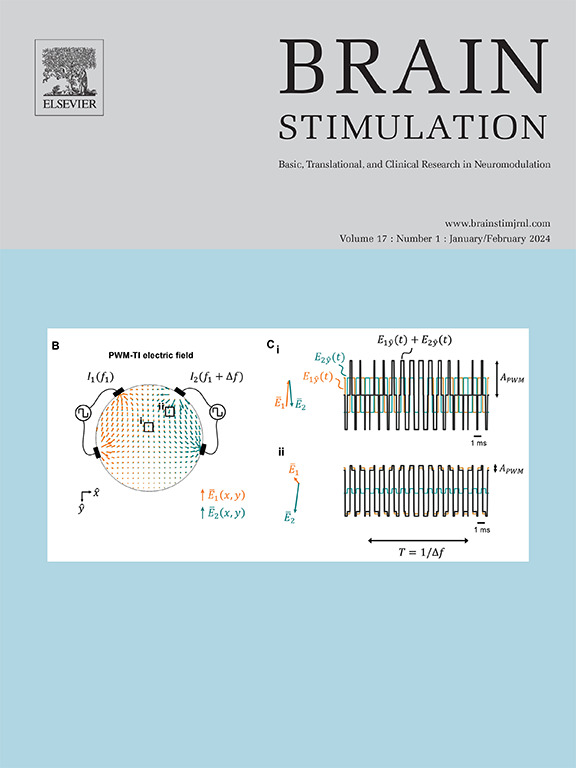聚焦超声在精神病学应用的路线图:2024年聚焦超声在精神病学研讨会论文集(FUS-PULSE)
IF 8.4
1区 医学
Q1 CLINICAL NEUROLOGY
引用次数: 0
摘要
经颅聚焦超声(FUS)是一种新兴的神经调节方式,可以实现无切口、空间精确靶向与神经精神疾病有关的深部脑结构。FUS精神病学越来越多的临床应用包括暂时性和永久性生物效应,包括局灶性病变、神经刺激和靶向药物递送。为了应对该领域的快速发展,一场面对面的多学科研讨会FUS-PULSE于2024年6月5日至7日在加拿大多伦多举行。会议召集了来自神经外科、精神病学、神经病学、心理学、放射学、神经影像学、物理学和工业界的70多名国际专家,评估了FUS精神病学领域的关键挑战并制定了前进的战略路径。重点强调了FUS- pulse的关键主题,包括整合基于电路的精确精神病学的需求,导航FUS设备和参数的发展前景,以及在病变,神经调节和药物传递方面推进临床应用。基于fus的干预措施可以补充现有的行为,药理和神经调节治疗,以扩大难治性精神疾病患者的选择。然而,在优化技术,包括治疗参数和制定临床方案方面仍然存在重大障碍。实地必须优先考虑标准化报告方法、协议协调和目标参与的实时监测。高强度的FUS损伤,特别是针对内囊前肢,显示出治疗重度抑郁症和强迫症的希望。微泡辅助病变技术的进步和最佳临床反应的靶标定位将进一步扩大靶向可能性并提高治疗效果。FUS神经调节和药物递送应用仍处于早期发展阶段,具有广阔的潜力。更深入地了解跨设备、参数和脑靶点的生物效应对成功的临床翻译至关重要。本文章由计算机程序翻译,如有差异,请以英文原文为准。
A roadmap for focused ultrasound applications in psychiatry: Proceedings of the 2024 symposium on focused ultrasound in psychiatry (FUS-PULSE)
Transcranial focused ultrasound (FUS) is an emerging neuromodulation modality that enables incisionless, spatially precise targeting of deep brain structures implicated in neuropsychiatric conditions. Growing clinical applications in FUS psychiatry encompass both transient and permanent bioeffects, including focal lesioning, neurostimulation, and targeted drug delivery.
In response to rapid advances in the field, an in-person multidisciplinary symposium, FUS-PULSE, was held in Toronto, Canada from June 5–7 2024. The meeting convened over 70 international experts across neurosurgery, psychiatry, neurology, psychology, radiology, neuroimaging, physics, and industry to evaluate critical challenges and chart a strategic path forward for the field of FUS psychiatry.
Key themes from FUS-PULSE are highlighted, including the need to integrate circuit-based precision psychiatry, navigating the evolving landscape of FUS devices and parameters, and advancing clinical applications across lesioning, neuromodulation, and drug delivery.
FUS-based interventions can complement existing behavioral, pharmacological and neuromodulatory treatments to expand options for patients with refractory psychiatric conditions. However, significant barriers remain in optimizing the technology including treatment parameters and developing clinical protocols. The field must prioritize standardized reporting methodologies, protocol harmonization and real-time monitoring of target engagement. High-intensity FUS lesioning, particularly targeting the anterior limb of the internal capsule, shows promise for major depressive disorder and obsessive-compulsive disorder. Advancements in microbubble-assisted lesioning techniques and target mapping for optimal clinical response will further expand targeting possibilities and improve treatment efficacy. FUS neuromodulation and drug delivery applications remain at an early stage of development with promising potential. A deeper understanding of bioeffects across devices, parameters, and brain targets will be critical for successful clinical translation.
求助全文
通过发布文献求助,成功后即可免费获取论文全文。
去求助
来源期刊

Brain Stimulation
医学-临床神经学
CiteScore
13.10
自引率
9.10%
发文量
256
审稿时长
72 days
期刊介绍:
Brain Stimulation publishes on the entire field of brain stimulation, including noninvasive and invasive techniques and technologies that alter brain function through the use of electrical, magnetic, radiowave, or focally targeted pharmacologic stimulation.
Brain Stimulation aims to be the premier journal for publication of original research in the field of neuromodulation. The journal includes: a) Original articles; b) Short Communications; c) Invited and original reviews; d) Technology and methodological perspectives (reviews of new devices, description of new methods, etc.); and e) Letters to the Editor. Special issues of the journal will be considered based on scientific merit.
 求助内容:
求助内容: 应助结果提醒方式:
应助结果提醒方式:


